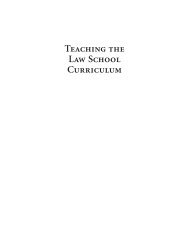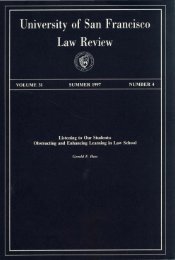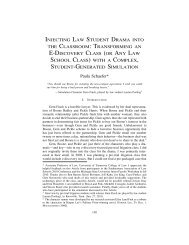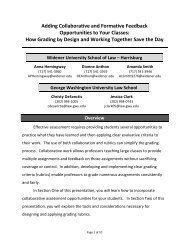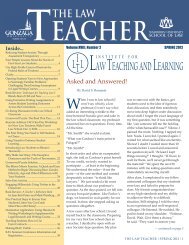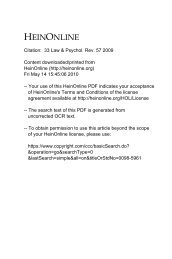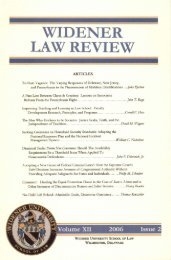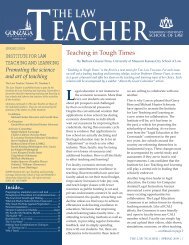The Law Teacher - Institute for Law Teaching and Learning
The Law Teacher - Institute for Law Teaching and Learning
The Law Teacher - Institute for Law Teaching and Learning
Create successful ePaper yourself
Turn your PDF publications into a flip-book with our unique Google optimized e-Paper software.
Project runway at LSU <strong>Law</strong><br />
By Paul r. Baier, Paul M. hebert <strong>Law</strong> center at Louisiana State University<br />
Editor’s Note: LSU’s playwright Paul<br />
R. Baier (“Father Chief Justice”: Edward<br />
Douglass White <strong>and</strong> the Constitution) has<br />
brought James Bradley Thayer’s monumental<br />
Cases on Constitutional <strong>Law</strong>, with Notes<br />
(1895) to Heidi Klum’s runway by way of his<br />
Aspen Custom Publishing Series casebook,<br />
cut from Thayer’s successors. Project<br />
Runway has come to LSU <strong>Law</strong>. His preface<br />
explains why he designed a garb of his own.<br />
Other law teachers may want to join him on<br />
the catwalk.<br />
casebook construction in<br />
constitutional law traces itself<br />
back to James Bradley Thayer’s<br />
monumental Cases on Constitutional<br />
<strong>Law</strong>, with Notes, published in 1895.<br />
Professor Thayer was Dean Langdell’s<br />
colleague on the harvard <strong>Law</strong> School<br />
faculty. Langdell taught contracts.<br />
Thayer taught constitutional <strong>Law</strong>. Both<br />
used a newfangled teaching tool that<br />
was all the rage at the time—christopher<br />
columbus Langdell’s ‘‘case method’’<br />
of instruction. It has ruled law school<br />
pedagogy <strong>for</strong> a long, long time. c. c.<br />
Langdell was a discoverer, heroic to my<br />
mind. Innovation always irritates the<br />
crowd. he had courage. he had the right<br />
namesake. he started out as a librarian<br />
in a New York law firm. Harvard’s<br />
President charles eliot later brought<br />
Langdell to harvard <strong>Law</strong> School as its<br />
first dean. According to Christopher<br />
columbus Langdell, ‘‘<strong>The</strong> law is a<br />
science. all the available materials of that<br />
science are contained in printed books.’’<br />
(I quote him exactly.) Dean Langdell was<br />
a bookworm’s bookworm.<br />
But what kind of printed book is best <strong>for</strong><br />
teaching constitutional <strong>Law</strong>? answering<br />
this question has been an adventure <strong>for</strong><br />
me <strong>and</strong> my students over the course<br />
of a generation of teaching law at LSU<br />
<strong>Law</strong> School. Professor Gerald Gunther’s<br />
Constitutional <strong>Law</strong>, now in its 17th<br />
Kathleen Sullivan edition, is a favorite of<br />
mine. It has deep roots. Gerry Gunther,<br />
whom I came to know <strong>and</strong> love (he<br />
played classical music in his office,<br />
while constructing each new edition of<br />
his casebook), was my James Bradley<br />
Thayer. Both were giants. <strong>The</strong>y shared<br />
a common pedagogical faith. here is<br />
Thayer’s, from his Preface—the first<br />
casebook in american constitutional<br />
<strong>Law</strong>:<br />
“IN preparing this book I have had<br />
chiefly in mind the wants of my own<br />
classes at the harvard <strong>Law</strong> School;<br />
of these <strong>and</strong> students elsewhere who<br />
follow similar methods of study. I am<br />
led to hope that the completed work<br />
may help to promote a deeper, more<br />
systematic, <strong>and</strong> exacter study of this<br />
most interesting <strong>and</strong> important subject,<br />
too neglected by the profession. It<br />
appears to me that what scientific men<br />
call the genetic method of study, which<br />
allows one to see the topic grow <strong>and</strong><br />
develop under his eye,—a thing always<br />
grateful <strong>and</strong> stimulating to the human<br />
faculties, as if they were called home<br />
to some native <strong>and</strong> congenial field,—is<br />
one peculiarly suited to the subject<br />
of constitutional <strong>Law</strong>. <strong>The</strong> study of<br />
constitutional <strong>Law</strong> is allied not merely<br />
with history, but with statecraft, <strong>and</strong><br />
with the political problems of our great<br />
<strong>and</strong> complex national life.”<br />
I share this Old School faith. Joseph<br />
Story’s teaching appeals to me. he<br />
was John Marshall’s great friend on<br />
the Supreme court at the dawn of<br />
constitutional <strong>Law</strong>. he taught the<br />
subject at harvard <strong>Law</strong> School while<br />
serving at the same time as an associate<br />
justice of the Supreme court of the<br />
United States.<br />
I lack Story’s credentials. But I like his<br />
aims: ‘‘what we propose is no more<br />
than plain, direct, familiar instruction;<br />
something to assist the student in the<br />
first steps of his studies; something to<br />
cheer him in his progress; something to<br />
disencumber him of difficulties by the<br />
wayside; something to awaken a sincere<br />
ambition <strong>for</strong> professional excellence.’’<br />
I have uttered a few public doubts<br />
about the capacity of the casebook to<br />
incubate great constitutional lawyers<br />
in our classes. Incubating such lawyers<br />
is one of my aims, although preparing<br />
students to argue constitutional cases in<br />
court is not one of the goals mentioned<br />
by constitutional law teachers when<br />
they sit down to discuss their work. To<br />
me, this omission is distressing. I like to<br />
ratiocinate over the commerce clause<br />
with the best of them, but what really<br />
rouses my students is hearing great<br />
lawyers arguing challenging cases in<br />
class. Take Ted Olson’s argument in Bush<br />
v. Gore <strong>for</strong> example. after his opening<br />
statement, Justice Kennedy comes to<br />
class to ask, ‘‘can you begin by telling us<br />
about our federal jurisdiction. where’s<br />
the federal question here?’’<br />
at this point, I click the mouse, whatever,<br />
<strong>and</strong> pause the argument. I put a student<br />
in <strong>The</strong>odore Olson’s shoes to answer the<br />
question. Nobody is sleeping. Nobody is<br />
hiding behind the laptop. everybody is<br />
engaged. why? This is the real thing.<br />
I use my friend Jerry Goldman’s Oyez<br />
Project in orchestrating a pedagogical<br />
symphony that brings my students into<br />
the crucible of the court, the Socratic<br />
dialogue that is the life of the mind. we<br />
get inside the Justices’s heads. <strong>The</strong>y<br />
come to class as academic support. Potter<br />
Stewart’s cross-examination of Special<br />
Prosecutor Leon Jaworski in the Nixon<br />
Tapes Case is a favorite cut of mine, off<br />
our Post-Langdellian Sound Machine. I<br />
once told Justice Stewart how he comes<br />
to my classes at LSU each spring via the<br />
Supreme court tapes. I liked him. we<br />
were both from cincinnati. I reminded<br />
him of his interrogation of Mr. Jaworski.<br />
I told him I put a student in Jaworski’s<br />
shoes <strong>and</strong> hear her answer first. What<br />
was his reaction? I had better quote him<br />
exactly. here is what Justice Stewart said<br />
to me in the Great hall of the Supreme<br />
— continued on page 38<br />
<strong>The</strong> <strong>Law</strong> <strong>Teacher</strong> | FaLL 2012 | 37




